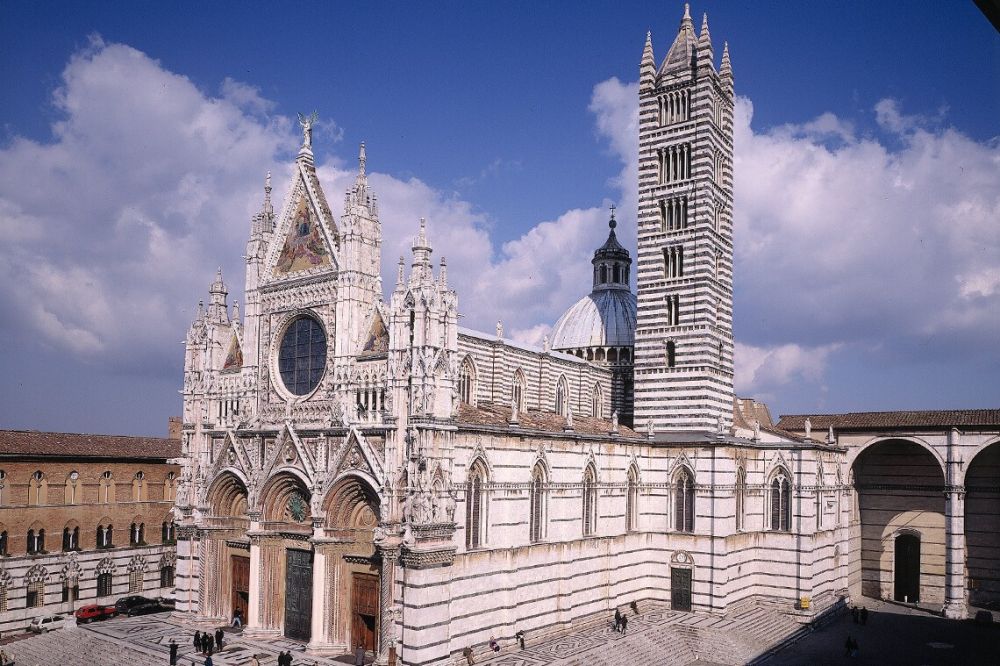

Siena Cathedral, also known as the Cathedral of Santa Maria Assunta, is one of the most spectacular examples of Italian Gothic architecture. It was originally designed and completed between 1215 and 1263, but it has since undergone several renovations and expansions, including the planned extension in the 14th century, which intended to make it the largest cathedral in existence. However, the project, known as "Il Duomo Nuovo," was abandoned due to the outbreak of the Black Plague.
The cathedral has been a key attraction in Siena for centuries, particularly for pilgrims traveling to Rome along the Via Francigena. Its impressive façade, intricate marble floor, and the wealth of art, including works by Michelangelo, Donatello, and Bernini, make it a highlight for visitors from around the world.
Tourism at Siena Cathedral has evolved with transportation and global travel trends. The advent of train travel in the 19th century, and later the rise of automobile touring, brought greater numbers of people to Siena. In the 20th century, as air travel became more accessible, the number of visitors from overseas increased significantly.
Post-World War II, there was a surge in international tourism, and Siena Cathedral became a must-visit destination on the cultural tourism map of Europe. Efforts to restore and preserve the cathedral began to ensure it could continue to welcome tourists without suffering damage.
Today's tourism at Siena Cathedral reflects a desire for authentic experiences and increased interest in sustainable travel. Visitors are often trying to connect with the historical and cultural essence of the cathedral rather than just pass through as spectators. Guided tours, educational programs, and virtual reality experiences have been introduced to meet this demand.
Local Experiences: In recent years, there has been a trend towards engaging in local experiences. Tourists take part in local festivals and events, such as the famous Palio horse race, which takes place in the Siena's main square, Piazza del Campo, and engage with the surrounding vibrant community.
Digital Involvement: With the rise of social media, digital experiences such as interactive apps offering immersive tours have become popular. These services often provide historical insights and multimedia content that enrich the tourist experience.
Educational Tourism: Siena Cathedral has also become a site of educational tourism, with art history enthusiasts and architecture students visiting to admire and study its structure and the masterpieces inside.
Sustainable Tourism: The emphasis on sustainability has impacted tourism in Siena, with initiatives to reduce the environmental footprint of travel. Visitors are encouraged to respect the site and initiatives are in place to manage tourist numbers during peak periods to preserve the cathedral's integrity.
Visitors to Siena Cathedral can enjoy various aspects of the site, including the main cathedral, the Piccolomini Library, with its frescoes by Pinturicchio, the Baptistery of San Giovanni, the crypt, and the Museum of the Opera Metropolitana. The Facciatone offers breathtaking views of the city for those willing to climb its steps.
Opening Hours: The Cathedral has different opening hours throughout the year, which can be found on its official website. Tickets for entry can be purchased online or on-site.
For those planning a visit, it's advisable to check the current travel trends and policies, including any COVID-19 related restrictions, which may affect travel plans to Italy and access to Siena Cathedral.
With its rich history, stunning art, and spiritual significance, Siena Cathedral remains one of Italy's treasured landmarks and continues to captivate tourists with its enduring beauty and historical importance.